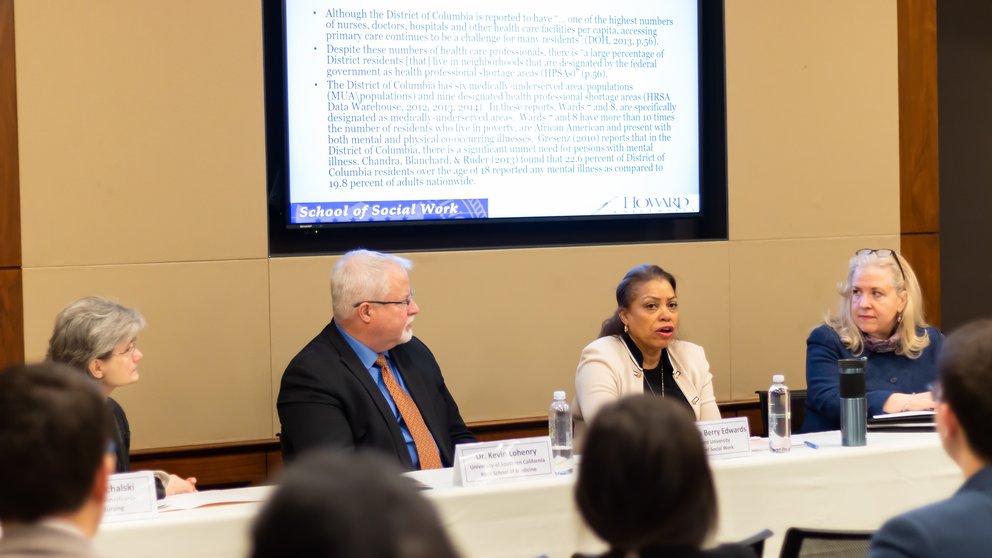
The Title VII Health Professions and Title VIII Nursing Workforce development programs play a critical role in training a workforce that meets the nation’s evolving health care needs. Through grant funding, these programs enable institutions to build pipelines of future health care professionals and address health inequities in their community.
The Health Professions and Nursing Education Coalition (HPNEC) advocates for the funding of the Title VII and Title VIII programs, authorized under the Public Health Service Act and administered by the Health Resources and Services Administration (HRSA), to allow them to continue to train the next generation of health professionals and connect them to medically underserved areas (MUAs) which ultimately help communities achieve better health.
A Capitol Hill briefing hosted by HPNEC on March 20 highlighted the work being done by academic medicine and others in health professions education to educate a diverse and culturally competent health care workforce. Speakers included Teresa Baker, senior government relations representative for the American Academy of Family Physicians; Janice Berry Edwards, MSW, PhD, LICSW, LCSW-C, ACSW, BCD, assistant professor at the Howard University School of Social Work; Kevin Lohenry, PhD, PA-C, director of the division of physician assistant studies at the University of Southern California (USC); and Julie A. Sochalski, PhD, FAAN, RN, associate professor of nursing and associate dean for academic programs at the University of Pennsylvania School of Nursing.
Each speaker highlighted their efforts to recruit and train a diverse group of health professions students that are willing to help improve the health of those living in MUAs by training, and later practicing, in these communities. Funding from HRSA’s Title VII and Title VIII programs allows their institutions to educate students in an interprofessional model that breaks down communication barriers between health care professionals and recruit and train a diverse and culturally competent health care workforce.

Berry Edwards works and teaches in the District of Columbia, a region that has the highest number of health care professionals in the country per capita and yet still has six separate MUAs. Her social work and behavioral health students at Howard University each get clinical experience in these parts of the District, with a focus on serving those with substance use disorders.
“What is needed is a clinical workforce with training that champions a sharp acumen for the challenges of opioid related disorders while simultaneously offering a clinical lens that is sensitive and responsive to the particularities of historically underserved populations,” said Berry Edwards.
The physician assistant program at USC headed by Lohenry emphasizes graduating a diverse group of students that are representative of the patient population in Los Angeles, and to that end, they have doubled the disadvantaged minority student population in recent years and expanded their K-12 pipeline programs.
“We are mindful of our mission to serve the medically underserved, and our HRSA Title VII grant allows us to do that.”
Kevin Lohenry, PhD, PA-C
Through her expertise in nursing education and health policy, Sochalski has found that mentorship for nursing and nurse practitioner students is critical to retaining them in MUAs after graduation, while also training them in a way that prepares them for working in under-resourced environments.
“It’s much more of a challenge to practice in an underserved area, but we can train our students to be able to respond to them with the same high-quality care expected elsewhere,” said Sochalski.
Baker, who moderated the panel, thanked Congress for years of previous investment in HRSA’s Title VII and Title VIII programs, but reminded the audience that there is always a need to advocate for the programs with members of Congress.
“Although we are sad to see it eliminated in the President’s proposed budget, we are hopeful that congress will continue to sustain and strengthen the nation’s investment in Title VII and Title VIII workforce development programs. Therefore, HPNEC recommends an investment of $690 million in FY 2020.”
The AAMC leads HPNEC, which is an alliance of more than 60 national organizations representing schools, programs, health professionals, and students dedicated to ensuring that the health care workforce is trained to meet the needs of our diverse population.